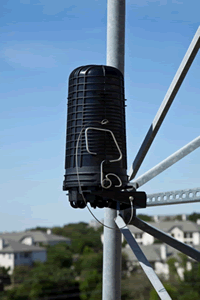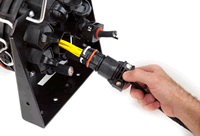Fiber Management Solutions to the Cell Tower
Fiber optic cable no longer stops at the base of the cell tower, and as mobile communication network operators deploy advanced 3G LTE/4G networks, it’s time to take a closer look at fiber management solutions to the cell tower.
This white paper excerpt was provided by 3M.  Fiber optic cable no longer stops at the base of the cell tower. As mobile communication network operators deploy advanced 3G and LTE/4G networks, many are pulling fiber right up the tower. Operators have found that fiber-to-the-antenna (FTTA) architectures offer a number of advantages over legacy coaxial systems, including improved signal integrity, capacity gains, smaller site footprint, and significantly lower energy consumption. However, with the benefits come new challenges. FTTA architectures call for more active components on the tower, resulting in new types of cables to manage, connect, and protect. Not all traditional tower connectivity solutions are applicable to FTTA systems. New solutions are in development, including a family of tower terminals specifically designed to meet the challenges of FTTA installations. The new terminals offer a number of advantages over traditional solutions and can help operators simplify cable management on the tower, provide reserve capability for future needs, and decrease operating expenses.
Fiber optic cable no longer stops at the base of the cell tower. As mobile communication network operators deploy advanced 3G and LTE/4G networks, many are pulling fiber right up the tower. Operators have found that fiber-to-the-antenna (FTTA) architectures offer a number of advantages over legacy coaxial systems, including improved signal integrity, capacity gains, smaller site footprint, and significantly lower energy consumption. However, with the benefits come new challenges. FTTA architectures call for more active components on the tower, resulting in new types of cables to manage, connect, and protect. Not all traditional tower connectivity solutions are applicable to FTTA systems. New solutions are in development, including a family of tower terminals specifically designed to meet the challenges of FTTA installations. The new terminals offer a number of advantages over traditional solutions and can help operators simplify cable management on the tower, provide reserve capability for future needs, and decrease operating expenses.
Cable Management Challenges on the Tower
FTTA cabling architectures differ, but they generally consist of a base band unit (BBU) at the bottom of the tower and multiple fiber-fed remote radio units (RRUs) up the mast. Discrete, trunked, or hybrid fiber and power cables run up the tower to the RRUs, which support advanced technologies, such as LTE/4G. Standard half-inch coaxial jumpers connect each RRU to one or more antennas. First-generation FTTA architectures use point-to-point fiber and power cables installed separately on the tower. One fiber and one power cable run directly from the BBU to each RRU. The initial deployment cost of this cabling method is relatively low, but it provides little flexibility for expansion because new power and fiber cables must be installed every time equipment is added to the tower. As the number of radios grows, this approach becomes more expensive than other alternatives because of the cost of installing, jacketing, and reinforcing each individual cable. Also, damaged cables must be replaced in their entirety (as opposed to replacing a short jumper), potentially increasing operating costs. Operators have learned that multiple-core, trunked fiber cabling and hybrid fiber-power cables can provide greater flexibility for future enhancements while potentially lowering capital expenditure and labor costs over time. However, unlike point-to-point cabling, trunked and hybrid cabling methods involve break-out points on the tower where individual fibers and power conductors split out from the cable to connect to each individual RRU. These vulnerable junctures must be managed and protected from weather in order to ensure reliable service. Cable management solutions currently used on the tower often prove less than ideal for advanced FTTA systems. Traditional solutions include break-out boots with pre-stretched tubing and metal or plastic box-like enclosures. Break-out boots don’t allow easy changes and maintenance (the boot must be cut off and replaced), and square boxes do not provide the most efficient effective projected area on the tower, paving the way for potential wind loading problems. Slack storage and robust cable retention can also be problems with these solutions, often requiring additional infrastructure or support to provide a complete solution.

3M Tower Dome Terminals simplify cable management, weatherproof sensitive connections, and enable quick and easy installation, leading to reduced operating costs and improved network reliability.
Domed-shaped terminals provide an alternative that addresses many of the issues associated with more basic cable management methods. The rounded shape decreases effective projected area compared to boxes, lowering total tower wind load. They require no special tools, tapes, or mastics for installation. In addition, changes and maintenance are generally less expensive because only short jumper cables, leading from the terminal to the RRU, are typically added or replaced as opposed to replacing an entire feeder cable. However, not all products are equal. Most domes on the market today require a heavy mounting bracket and cable retention device, which can counteract any savings in footprint, and they can be clumsy to handle due to the need for tools and multiple parts that must be handled on the tower.

A key feature of the Tower Dome Terminals from 3M is the plug-and-play External Cable Assembly Module (ECAM) that enables the cable to simply snap into the port while still forming a good weatherproof seal.
New solutions in tower-mounted terminals have emerged to support varying FTTA architectures. For example, the 3M Tower Dome Terminal product family for fiber and power cables provides solutions supporting common FTTA cabling architectures. The terminals are designed to help simplify cable management, weatherproof sensitive connections, and enable plug-and-play installations. Incorporating the terminals into FTTA cabling designs can help reduce operating costs, improve network reliability, and create a more flexible system that can be easily grown and altered to meet evolving network demands.
To read this white paper in its entirety, please click here.
[hr]
Author Stephen C. King is a wireless applications engineer at 3M Communication Markets Division.

